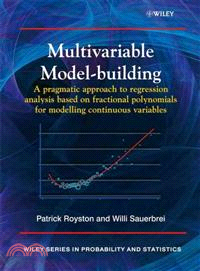Multivariable Model-Building - A Pragmatic Approach To Regression Anaylsis Based On Fractional Polynomials For Modelling Continuous
商品資訊
定價
:NT$ 7065 元優惠價
:90 折 6359 元
若需訂購本書,請電洽客服 02-25006600[分機130、131]。
相關商品
商品簡介
作者簡介
名人/編輯推薦
目次
商品簡介
Multivariable regression models are of fundamental importance in all areas of science in which empirical data must be analyzed. This book proposes a systematic approach to building such models based on standard principles of statistical modeling. The main emphasis is on the fractional polynomial method for modeling the influence of continuous variables in a multivariable context, a topic for which there is no standard approach. Existing options range from very simple step functions to highly complex adaptive methods such as multivariate splines with many knots and penalisation. This new approach, developed in part by the authors over the last decade, is a compromise which promotes interpretable, comprehensible and transportable models.
作者簡介
Patrick Royston DSc, is a senior statistician and cancer clinical realist at the MRC Clinical Trials Unit, London, an honorary professor of statistics at University College London and a fellow of the Royal Statistical Society. he has authored many research papers in biostatistics, and has published over 150 articles in leading statistical journals. Patrick is an experienced statistical consultant, Stata programmer and software author.
Willi Sauerbrei PhD, is a senior statistician and professor in medical biometry at the IMBI, University Medical Center Freiburg. He has authored many research papers in biostatistics and has published over 100 articles in leading statistical and clinical journals. He worked for more than two decades as an academic biostatistician and has extensive experience of cancer research, with a particular concern for breast cancer.
Willi Sauerbrei PhD, is a senior statistician and professor in medical biometry at the IMBI, University Medical Center Freiburg. He has authored many research papers in biostatistics and has published over 100 articles in leading statistical and clinical journals. He worked for more than two decades as an academic biostatistician and has extensive experience of cancer research, with a particular concern for breast cancer.
名人/編輯推薦
The book is very useful for practicing statisticians and can also be recommended for teaching purposes. (Biometrical Journal, July 2009)
It is an excellent book on multivariable model-building, presenting the material in an easy-to-understand and informal style. (Mathematical Reviews, 2009)
"This excellent book fills a gap in the current literature on statistical modelling. It is the first time that a book is devoted to the whole breadth of application of fractional polynomials. The authors are the experts on this useful methodology." (Statistics in Medicine, Feb 2009)
It is an excellent book on multivariable model-building, presenting the material in an easy-to-understand and informal style. (Mathematical Reviews, 2009)
"This excellent book fills a gap in the current literature on statistical modelling. It is the first time that a book is devoted to the whole breadth of application of fractional polynomials. The authors are the experts on this useful methodology." (Statistics in Medicine, Feb 2009)
目次
Preface.
1. Introduction.
1.1 Real-Life Problems as Motivation for Model Building.
1.2 Issues in Modelling Continuous Predictors.
1.3 Types of Regression Model Considered.
1.4 Role of Residuals.
1.5 Role of Subject-Matter Knowledge in Model Development.
1.6 Scope of Model Building in our Book.
1.7 Modelling Preferences.
1.8 General Notation.
2. Selection of Variables.
2.1 Introduction.
2.2 Background.
2.3 Preliminaries for a Multivariable Analysis.
2.4 Aims of Multivariable Models.
2.5 Prediction: Summary Statistics and Comparisons.
2.6 Procedures for Selecting Variables.
2.7 Comparison of Selection Strategies in Examples.
2.8 Selection and Shrinkage.
2.9 Discussion.
3. Handling Categorical and Continuous Predictors.
3.1 Introduction.
3.2 Types of Predictor.
3.3 Handling Ordinal Predictors.
3.4 Handling Counting and Continuous Predictors: Categorization.
3.5 Example: Issues in Model Building with Categorized Variables.
3.6 Handling Counting and Continuous Predictors: Functional Form.
3.7 Empirical Curve Fitting.
3.8 Discussion.
4. Fractional Polynomials for One Variable.
4.1 Introduction.
4.2 Background.
4.3 Definition and Notation.
4.4 Characteristics.
4.5 Examples of Curve Shapes with FP1 and FP2 Functions.
4.6 Choice of Powers.
4.7 Choice of Origin.
4.8 Model Fitting and Estimation.
4.9 Inference.
4.10 Function Selection Procedure.
4.11 Scaling and Centering.
4.12 FP Powers as Approximations to Continuous Powers.
4.13 Presentation of Fractional Polynomial Functions.
4.14 Worked Example.
4.15 Modelling Covariates with a Spike at Zero.
4.16 Power of Fractional Polynomial Analysis.
4.17 Discussion.
5. Some Issues with Univariate Fractional Polynomial Models.
5.1 Introduction.
5.2 Susceptibility to Influential Covariate Observations.
5.3 A Diagnostic Plot for Influential Points in FP Models.
5.4 Dependence on Choice of Origin.
5.5 Improving Robustness by Preliminary Transformation.
5.6 Improving Fit by Preliminary Transformation.
5.7 Higher Order Fractional Polynomials.
5.8 When Fractional Polynomial Models are Unsuitable.
5.9 Discussion.
6. MFP: Multivariable Model-Building with Fractional Polynomials.
6.1 Introduction.
6.2 Motivation.
6.3 The MFP Algorithm.
6.4 Presenting the Model.
6.5 Model Criticism.
6.6 Further Topics.
6.7 Further Examples.
6.8 Simple Versus Complex Fractional Polynomial Models.
6.9 Discussion.
7. Interactions.
7.1 Introduction.
7.2 Background.
7.3 General Considerations.
7.4 The MFPI Procedure.
7.5 Example 1: Advanced Prostate Cancer.
7.6 Example 2: GBSG Breast Cancer Study.
7.7 Categorization.
7.8 STEPP.
7.9 Example 3: Comparison of STEPP with MFPI.
7.10 Comment on Type I Error of MFPI.
7.11 Continuous-by-Continuous Interactions.
7.12 Multi-Category Variables.
7.13 Discussion.
8. Model Stability.
8.1 Introduction.
8.2 Background.
8.3 Using the Bootstrap to Explore Model Stability.
8.4 Example 1: Glioma Data.
8.5 Example 2: Educational Body-Fat Data.
8.6 Example 3: Breast Cancer Diagnosis.
8.7 Model Stability for Functions.
8.8 Example 4: GBSG Breast Cancer Data.
8.9 Discussion.
9. Some Comparisons of MFP with Splines.
9.1 Introduction.
9.2 Background.
9.3 MVRS: A Procedure for Model Building with Regression Splines.
9.4 MVSS: A Procedure for Model Building with Cubic Smoothing Splines.
9.5 Example 1: Boston Housing Data.
9.6 Example 2: GBSG Breast Cancer Study.
9.7 Example 3: Pima Indians.
9.8 Example 4: PBC.
9.9 Discussion.
10. How To Work with MFP.
10.1 Introduction.
10.2 The Dataset.
10.3 Univariate Analyses.
10.4 MFP Analysis.
10.5 Model Criticism.
10.6 Stability Analysis.
10.7 Final Model.
10.8 Issues to be Aware of .
10.9 Discussion.
11. Special Topics Involving Fractional Polynomials.
11.1 Time-Varying Hazard Ratios in the Cox Model.
11.2 Age-specific Reference Intervals.
11.3 Other Topics.
12. Epilogue.
12.1 Introduction.
12.2 Towards Recommendations for Practice.
12.3 Omitted Topics and Future Directions.
12.4 Conclusion.
Appendix A: Data and Software Resources.
A.1 Summaries of Datasets.
A.2 Datasets used more than once.
A.2.1 Research Body Fat.
A.2.2 GBSG Breast Cancer.
A.2.3 Educational Body Fat.
A.2.4 Glioma.
A.2.5 Prostate Cancer.
A.2.6 Whitehall I.
A.2.7 PBC.
A.2.8 Oral Cancer.
A.2.9 Kidney Cancer.
A.3 Software.
Appendix B: Glossary of Abbreviations.
References.
Index
1. Introduction.
1.1 Real-Life Problems as Motivation for Model Building.
1.2 Issues in Modelling Continuous Predictors.
1.3 Types of Regression Model Considered.
1.4 Role of Residuals.
1.5 Role of Subject-Matter Knowledge in Model Development.
1.6 Scope of Model Building in our Book.
1.7 Modelling Preferences.
1.8 General Notation.
2. Selection of Variables.
2.1 Introduction.
2.2 Background.
2.3 Preliminaries for a Multivariable Analysis.
2.4 Aims of Multivariable Models.
2.5 Prediction: Summary Statistics and Comparisons.
2.6 Procedures for Selecting Variables.
2.7 Comparison of Selection Strategies in Examples.
2.8 Selection and Shrinkage.
2.9 Discussion.
3. Handling Categorical and Continuous Predictors.
3.1 Introduction.
3.2 Types of Predictor.
3.3 Handling Ordinal Predictors.
3.4 Handling Counting and Continuous Predictors: Categorization.
3.5 Example: Issues in Model Building with Categorized Variables.
3.6 Handling Counting and Continuous Predictors: Functional Form.
3.7 Empirical Curve Fitting.
3.8 Discussion.
4. Fractional Polynomials for One Variable.
4.1 Introduction.
4.2 Background.
4.3 Definition and Notation.
4.4 Characteristics.
4.5 Examples of Curve Shapes with FP1 and FP2 Functions.
4.6 Choice of Powers.
4.7 Choice of Origin.
4.8 Model Fitting and Estimation.
4.9 Inference.
4.10 Function Selection Procedure.
4.11 Scaling and Centering.
4.12 FP Powers as Approximations to Continuous Powers.
4.13 Presentation of Fractional Polynomial Functions.
4.14 Worked Example.
4.15 Modelling Covariates with a Spike at Zero.
4.16 Power of Fractional Polynomial Analysis.
4.17 Discussion.
5. Some Issues with Univariate Fractional Polynomial Models.
5.1 Introduction.
5.2 Susceptibility to Influential Covariate Observations.
5.3 A Diagnostic Plot for Influential Points in FP Models.
5.4 Dependence on Choice of Origin.
5.5 Improving Robustness by Preliminary Transformation.
5.6 Improving Fit by Preliminary Transformation.
5.7 Higher Order Fractional Polynomials.
5.8 When Fractional Polynomial Models are Unsuitable.
5.9 Discussion.
6. MFP: Multivariable Model-Building with Fractional Polynomials.
6.1 Introduction.
6.2 Motivation.
6.3 The MFP Algorithm.
6.4 Presenting the Model.
6.5 Model Criticism.
6.6 Further Topics.
6.7 Further Examples.
6.8 Simple Versus Complex Fractional Polynomial Models.
6.9 Discussion.
7. Interactions.
7.1 Introduction.
7.2 Background.
7.3 General Considerations.
7.4 The MFPI Procedure.
7.5 Example 1: Advanced Prostate Cancer.
7.6 Example 2: GBSG Breast Cancer Study.
7.7 Categorization.
7.8 STEPP.
7.9 Example 3: Comparison of STEPP with MFPI.
7.10 Comment on Type I Error of MFPI.
7.11 Continuous-by-Continuous Interactions.
7.12 Multi-Category Variables.
7.13 Discussion.
8. Model Stability.
8.1 Introduction.
8.2 Background.
8.3 Using the Bootstrap to Explore Model Stability.
8.4 Example 1: Glioma Data.
8.5 Example 2: Educational Body-Fat Data.
8.6 Example 3: Breast Cancer Diagnosis.
8.7 Model Stability for Functions.
8.8 Example 4: GBSG Breast Cancer Data.
8.9 Discussion.
9. Some Comparisons of MFP with Splines.
9.1 Introduction.
9.2 Background.
9.3 MVRS: A Procedure for Model Building with Regression Splines.
9.4 MVSS: A Procedure for Model Building with Cubic Smoothing Splines.
9.5 Example 1: Boston Housing Data.
9.6 Example 2: GBSG Breast Cancer Study.
9.7 Example 3: Pima Indians.
9.8 Example 4: PBC.
9.9 Discussion.
10. How To Work with MFP.
10.1 Introduction.
10.2 The Dataset.
10.3 Univariate Analyses.
10.4 MFP Analysis.
10.5 Model Criticism.
10.6 Stability Analysis.
10.7 Final Model.
10.8 Issues to be Aware of .
10.9 Discussion.
11. Special Topics Involving Fractional Polynomials.
11.1 Time-Varying Hazard Ratios in the Cox Model.
11.2 Age-specific Reference Intervals.
11.3 Other Topics.
12. Epilogue.
12.1 Introduction.
12.2 Towards Recommendations for Practice.
12.3 Omitted Topics and Future Directions.
12.4 Conclusion.
Appendix A: Data and Software Resources.
A.1 Summaries of Datasets.
A.2 Datasets used more than once.
A.2.1 Research Body Fat.
A.2.2 GBSG Breast Cancer.
A.2.3 Educational Body Fat.
A.2.4 Glioma.
A.2.5 Prostate Cancer.
A.2.6 Whitehall I.
A.2.7 PBC.
A.2.8 Oral Cancer.
A.2.9 Kidney Cancer.
A.3 Software.
Appendix B: Glossary of Abbreviations.
References.
Index
主題書展
更多
主題書展
更多書展本週66折
您曾經瀏覽過的商品
購物須知
外文書商品之書封,為出版社提供之樣本。實際出貨商品,以出版社所提供之現有版本為主。部份書籍,因出版社供應狀況特殊,匯率將依實際狀況做調整。
無庫存之商品,在您完成訂單程序之後,將以空運的方式為你下單調貨。為了縮短等待的時間,建議您將外文書與其他商品分開下單,以獲得最快的取貨速度,平均調貨時間為1~2個月。
為了保護您的權益,「三民網路書店」提供會員七日商品鑑賞期(收到商品為起始日)。
若要辦理退貨,請在商品鑑賞期內寄回,且商品必須是全新狀態與完整包裝(商品、附件、發票、隨貨贈品等)否則恕不接受退貨。
























